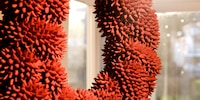
Background information
From volcanoes to the Alps – when Mexican design meets Swiss expertise
by Pia Seidel

Palma is a Brazilian creative studio based in São Paulo, founded in 2020 by artist Cleo Döbberthin and architect Lorenzo Lo Schiavo. The duo work in the fields of stage design, graphic design, interior design and product design. They recently showcased a collection influenced by game aesthetics.
When it’s showcased at Milan Design, Bingo – Collection No. 2 by Palma seems unassuming from a distance. Located in a courtyard garage, it features lamps, tables and armchairs in muted colours. Once I get up close, however, I’m astounded by the objects and the way they’ve incorporated elements I’m familiar with from board games. This is no coincidence. In this interview, Lorenzo Lo Schiavo tells me why the studio considers gimmicks to be particularly important in the design process.
At first glance, the pieces in Bingo – Collection No. 2 look very different. What do they have in common?
Lorenzo Lo Schiavo: They follow the same creative approach, characterised by both the game aesthetic concept and manufacturing method. What fascinates us about game aesthetics is how they invite the viewer to interact with the piece. The pieces also share a tactile approach; we juxtaposed polished surfaces with rough ones. While the «Jogo do Ganso» (Game of the Goose) mirror has a triple patina, the «Biscoito» table has a unique, smooth surface that creates a trompe-l'œil effect. The latter was created using a process we developed ourselves for layering aluminium foil, resin, fibreglass and other materials.



Your «Mikado» table lamp has sticks, much like the game Mikado does. How did you come up with the idea of using fragile elements like these as a lamp base?
When we were researching games, we came across Mikado sticks and thought they were the perfect inspiration for some pieces. We’d been meaning to work on a millipede idea for a lamp for some time. That’s why the Mikado set with its 41 sticks seemed like a good starting point.

Are these fun elements something you actively pursue in your designs or is it sheer coincidence?
We wouldn’t say we deliberately go for a fun look and feel, although many people interpret our work that way. At the same time, we embrace happenstance in the design process. We have a very open-ended approach when designing our collections. Mistakes, trial and error and even puns play a major role in the early stages. The process itself is fun, as we often have no idea where we’ll end up and how things will fall into place. We could maybe describe the fun element as an expected coincidence.



So how would you sum up the theme that guides your designs?
We see design as an ongoing, often circular dialogue between our references, experiments and previous works. We believe that interesting results can be achieved by merging various elements together. For instance, Italian architect Andrea Palladio, YouTube tutorials and donuts. Because there are two of us, we’re constantly trying to combine our different ideas. This amalgamation, as well as material experiments in our studio, help us find new, unexpected ways of working and expressing ourselves creatively.

As well as the approach you take, your choice of materials is also unusual. Your «Estrela» lamp, for example, is made of coconut fibre sponges. Where did you get the idea of using that material?
Coconut fibre is a material that we’ve been exploring since making our first pieces. The things we like about it are its rich natural colour and unique feel. Besides that, it’s a very inexpensive and widely used material. As it’s usually made into either slabs or sponges, we’ve used both in this collection. It boasts great potential in terms of shape and structure. Like a game, it invites the viewer to touch and interact with it.
Do you deliberately use natural materials such as coconut fibre and eggshells?
We wanted to work with eggshell mosaic even before we started making furniture. We’d become aware of it through the work of the Swiss-French lacquer artist Jean Dunand as well as Japanese lacquer art in general. We were immediately attracted to its beautiful texture, surface finish and varied uses.
I imagine working with eggshells is as fiddly as playing Mikado. How did you tackle that?
For the first pieces we made using this technique, we actually got the eggs together ourselves – we used ones we’d eaten for breakfast. First, we had to learn how to use the material by doing internet tutorials and reading the very few written sources out there, as we couldn’t find a suitable supplier. We think unusual, natural materials like this have unique properties. It’s great that we’ve now found a way to use them instead of throwing them away.
Like a cheerleader, I love celebrating good design and bringing you closer to everything furniture- and interior design- related. I regularly curate simple yet sophisticated interior ideas, report on trends and interview creative minds about their work.